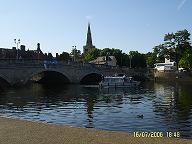How Bedford became ...Little Italia
There is one reason why Bedford is so Italian-during the
1950s the town was brought to life again with a little bit of Mediterranean passion.
More than 7,500 men arrived between 1951 and the early
1960s from the impoverished villages of in southern Italy ready to fill the vacancies at Marston Valley Brick Company, created
by the reconstruction boom.
Each man was given a medical examination, a ticket
to England and a bed. For those used to life on the land the adjustment to English culture was difficult and so many
returned home.
But those who stayed paid for their families to join
them creating the foundation of Bedford thriving Italian community. There are estimated to be 14,000 people of Italian
origin living in Bedfordshire, most of these in Bedford itself. Now the town has an Italian Vice-Consulate and even BBC
Three Counties Radio has a weekly Programme (Mondo Italiano) dedicated to the the Italian population.
The post-Second World War building boom created a
shortage of labour at Bedford's brickworks, which many Englishmen were reluctant to fill. Struggling to meet the demand,
the company started to look overseas and found the Italians more than willing to undertake heavy manual work.
The economic conditions in southern Italy-also known
as mezzogiorno-were difficult at this time. Unemployment was, high, the south lagged behind the north and even Italian government
promoted the option of emigration after its attempts to restore the south failed.
But many Italians could not afford the cost of travel
to England and therefore relied on 'paid passages' offered by companies, such as Bedford Brickworks, as a passport to a new
life.
In 1951 Marston Valley Brick Company established an
office in Naples to recruit 250 men. By the start of the 1960s more than 7,500 Italian men were working in Bedford.
To start with it was only single men who travelled
to Bedford. It was intended they would return home once they had earned enough to make a difference at home.
Over 60 per cent returned home within four years but the
remainder paid for their families to join them which kept a steady flow of Italians into the area during the late 1950s and
early 1960s. By 1958 approximately 85 per cent of the new arrivals were married women joining their husbands.
The new arrivals were basically penniless and had
no alternative but to stay in the hostels organised by the brick companies. After years of hard graft and saving, many
moved to shared accomodation on Midland Road, which soon became Bedford's 'Little Italia'.
Exploited
!
But although they were living in a tight-knit
community, it didn't stop many being exploited by their landlords. It was reported at the time that up to 50 people were being
crammed into houses designed for two families and that some landlords even started to let the same bed to more than one worker
to take advantage of the brick-workers' shift patterns.
By 1956 the Rent Act was amended in Parliament
to protect Italians living in England and a loan scheme was established to help Italians to purchase thei own homes.
Today, the second , third and even fourth
generations of Italians are Bedford citizen in their own right and have stamped their identity thoughout the town with their
array of restaurants, cafes, bakeries, delicatessens and even their own church funded by donations from their own community.
While
many young Italians now speak English at home, don't go to church or eat with their families on Sunday, last week's ( 9/7/2006 )World Cup celebrations proved they
are still Italian at heart.

